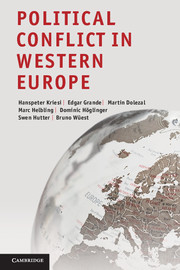Book contents
- Frontmatter
- Contents
- List of Figures
- List of Tables
- Preface and acknowledgments
- Part I Theory and methods
- Part II The development of the ‘integration–demarcation’ cleavage
- 3 Participation and party choice: comparing the demand side of the new cleavage across arenas
- 4 Restructuring the national political space: the supply side of national electoral politics
- 5 Restructuring the European political space: the supply side of European electoral politics
- 6 Restructuring protest politics: the terrain of cultural winners
- 7 Congruence, counterweight, or different logics? Comparing electoral and protest politics
- Part III Public debates: the articulation of the new cleavage in detail
- Part IV Conclusion
- References
- Index
4 - Restructuring the national political space: the supply side of national electoral politics
Published online by Cambridge University Press: 05 August 2012
- Frontmatter
- Contents
- List of Figures
- List of Tables
- Preface and acknowledgments
- Part I Theory and methods
- Part II The development of the ‘integration–demarcation’ cleavage
- 3 Participation and party choice: comparing the demand side of the new cleavage across arenas
- 4 Restructuring the national political space: the supply side of national electoral politics
- 5 Restructuring the European political space: the supply side of European electoral politics
- 6 Restructuring protest politics: the terrain of cultural winners
- 7 Congruence, counterweight, or different logics? Comparing electoral and protest politics
- Part III Public debates: the articulation of the new cleavage in detail
- Part IV Conclusion
- References
- Index
Summary
Introduction
In this chapter, we take up the analysis of the supply side where we left off in our previous volume (Kriesi et al. 2008). Our goal is to test whether our sweeping generalizations hold up when confronted with data that include later national elections in our six countries. The addition of new data allows us to distinguish between the 1990s and the 2000s, and to analyse developments over time. We are freed from the vicissitudes of political conjunctures in individual elections, given that we have at least two elections in both the 1990s and the 2000s to work with (see Table 2.1). We are now in a position to identify long-term trends in the structural configuration of national political space better than we were before.
We begin by analysing the overall structural transformation of national political space in Western Europe. As before, our analysis is based on content analysis of electoral campaign coverage in the major daily newspapers in the six countries (see Chapter 2 for details). We have sufficient data on 92 parties from our six countries.
In a first step, we include all parties in the same analysis. By situating the parties from all six countries, independently of national specificities, we can identify in a common West European space the overall structure of that particular space. This presupposes that the meaning of a given issue category (such as opposition to immigration) is roughly comparable across countries – an assumption that may not hold up for every case. Nevertheless, we believe it is not far off the mark for most issue-party combinations in our six countries.
- Type
- Chapter
- Information
- Political Conflict in Western Europe , pp. 96 - 126Publisher: Cambridge University PressPrint publication year: 2012
- 11
- Cited by

